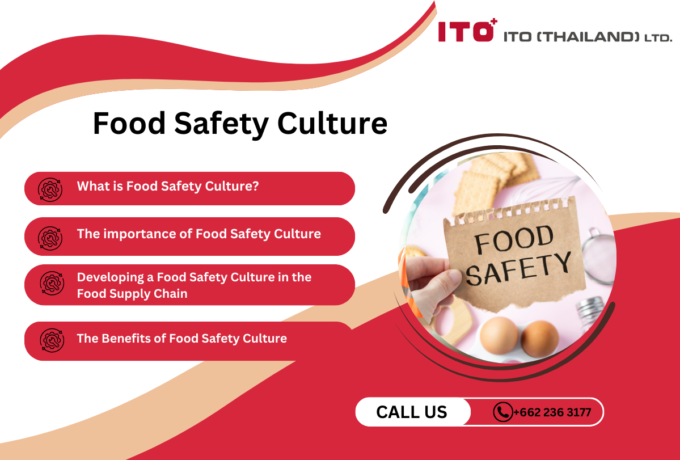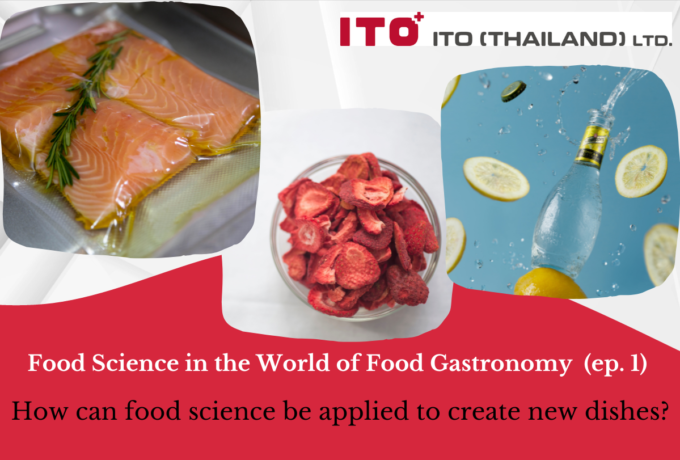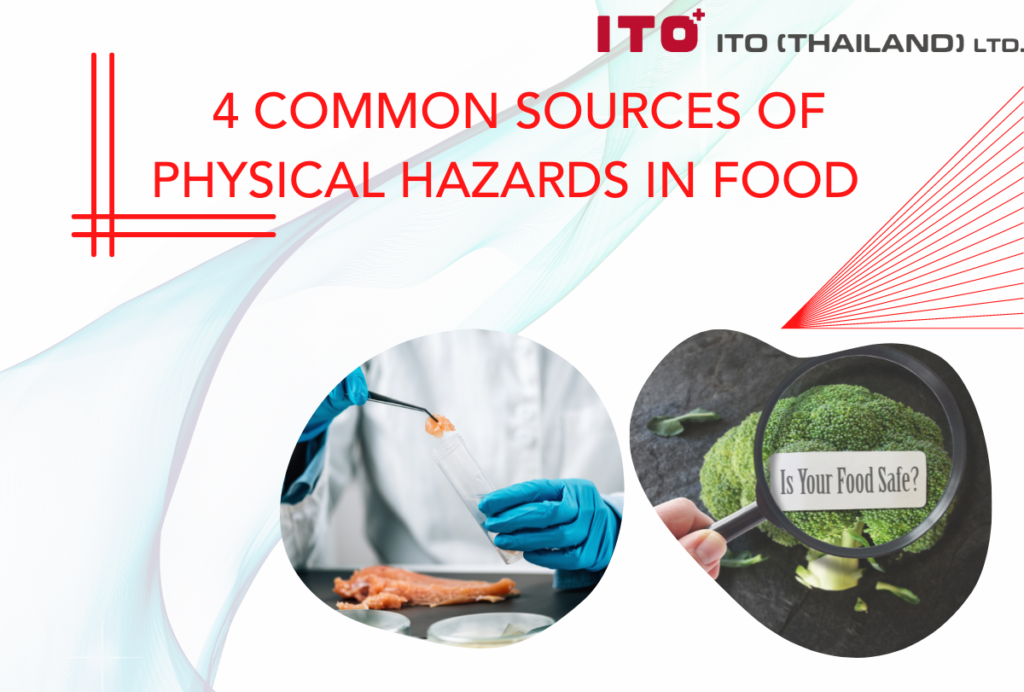ITO Thailand Hygiene Blog
Physical Hazard Contamination
Common physical hazards in food are caused by eating hard or sharp objects, or objects of a size that can clog the airway, resulting in choking, suffocation, wounds in the gastrointestinal tract, broken, chipped, cracked teeth, gingivitis, etc. These directly affect the health of consumers. Physical contamination may have serious consequences to the extent of recalling products from consumers. For example, in 2018, the US Food and Drug Administration recalled cod fish products [2] because they were contaminated with plastic scraps that could cause injury or be lodged in the throat. These plastic scraps are from inspection tags or labels showing information from the raw material manufacturer. Another instance is the recall of hashbrown potato products [3] due to contamination of golf ball material. This contamination is caused by improper harvesting of potatoes, promoting the need to recall the products for the safety of consumers.
Therefore, it is undeniable that physical hazards are of paramount importance in the food industry and manufacturers need to pay attention to prevent them.
Standards on Hazardous Physical Material Contamination
In Thailand’s standards, the size of materials identified as physically hazardous is not defined. However, USFDA CPG Sec. 555.425 Foods, Adulteration Involving hard or Sharp Foreign Objects [ 1]) is generally used as a reference. The standard stipulates as follows:
1.Hard or sharp natural components of a food e.g., shell in nut products, fishbones are unlikely to cause injury because of awareness on the part of the consumer that the component is a natural and intrinsic component. The exception occurs when the food label represents that the hard or sharp component has been removed from the food, but these components or their fragments are still present (e.g., pit fragments in products specifying pitted cherries). This may cause unexpected injury.
2.Hazardous material size in ready-to-eat food or food requiring minimal process that does not eliminate the hazards (for example, simply reheating before eating) is a hard or sharp object that measures 7 mm to 25 mm in length.
3.In cases where objects of 7-25 mm are contaminated in the product requiring additional preparation steps where hazards can be eliminated (e.g., sifting), the appropriate preparation method (e.g., the sieve aperture size sufficient for eliminating the hazards) must be specified.
4.In case the product is targeted at risky or sensitive groups (e.g., infants, patients, the elderly), contaminated materials smaller than 7 mm pose a risk of hazards.
5.Materials longer than 25 millimeters pose a general health hazard.
Common sources of physical hazards 4,5]
•Raw materials
Physical hazards from raw materials may be caused by the raw material manufacturers who do not practice appropriate hygiene, are careless or unaware of safety, such as careless harvesting causing contamination of foreign objects from the environment such as gravel, sand, twigs, stones, etc., packaging containing the raw materials such as plastic bags, wooden pallets, boxes, crates, as well as various identification tags are not appropriate, broken, damaged, and contaminate the product. Also, the physical hazards could be caused by improper processing of raw materials, errors, insufficient preventive measures such as bone fragments from dissecting animal carcasses, grain fragments (hard and large) left from the seed removal process, etc.
•Employees
Employees can be a source of physical contamination, such as hair, body hair, debris attached to their clothes or shoes [Read more]. In addition, the employees may also introduce foreign matters into the production such as jewelry, pen caps, buttons, fake nails, gum, tissue paper, plaster bandages, etc., which may contaminate the food.
•Equipment, tools, machinery in the production process
Equipment related to the production process such as gloves, blades, plastic bag staples, nuts, screws, steel scraps, insulation scraps, rubber scraps from production machinery, broken glass from related equipment such as pressure gauge covers, glass jars, thermometers, etc. may accidentally contaminate the product if they broke, become carelessly handled, or wear and tear over time.
•Surroundings
The surroundings that may be physically contaminating may refer to building materials, wires, construction materials such as rubble, sand, cement, bricks, glass, metal, wood, tile fragments, paint fragments from walls, foreign matters from pests, animal droppings, insect remains [Read more].
It can be seen that the physical contamination come from many sources to consider. Next time, we will talk about protection and reduction of the risk of physical hazards. We are pleased to be part of building a safe food society and raising production standards in the food industry in Thailand.
Please stay tuned to quality content from Ito (Thailand) every week on our website and at Facebook ITO Hygiene Thailand.
References
1.2005. CPG Sec. 555.425 Foods, Adulteration Involving hard or Sharp Foreign Objects. Online: https://www.fda.gov/media/71953/download?fbclid=IwAR3mT-oWxNmWUbFAtQB9ctaHQzyMEnVK98HJ4-qa2ZZAM7iTp2NCjdv-P8U
2.2018. Trident Seafoods Corporation Recalls Frozen Multi-Grain Alaskan Cod Due to Possible Health Risk. https://www.fda.gov/safety/recalls-market-withdrawals-safety-alerts/trident-seafoods-corporation-recalls-frozen-multi-grain-alaskan-cod-due-possible-health-risk
3.2018. McCain Foods USA, Inc. Recalls Frozen Southern Style Hash Browns Due to Possible Health Risk. Product is Sold and Distributed Under The Roundy’s and Harris Teeter Retail Brands. https://www.fda.gov/safety/recalls-market-withdrawals-safety-alerts/mccain-foods-usa-inc-recalls-frozen-southern-style-hash-browns-due-possible-health-risk-product-sold
4.สุพจน์ บุญแรง. (2547). การควบคุมคุณภาพอาหาร.เชียงใหม่: มหาวิทยาลัยราชภัฏเชียงใหม่.
5.College of Applied Medical Science Department of Environmental Health. 2018. Introduction to Food Safety and Microbiology Lecture 7 PHYSICAL FOOD OF CONTAMINATION. online: http://ams.uokerbala.edu.iq/wp/wp-content/uploads/2018/03/LEC7-food-safrty.pdf
Related Post
-

Food Safety Culture
Food safety culture plays a crucial role in safeguarding the company's reputation, ensuring the well-being of its employees, and providing a safe experience for its customers.
-

New food source safety issues
What are safety issues worth knowing for trendy new food sources like plant-based and insect-based proteins?
-

British Retail Consortium (BRC) Standard
Food safety management systems play a vital role in ensuring the production and distribution of safe and high-quality food products to consumers. With the global food supply chain becoming increasingly complex, food businesses must implement effective systems prioritising safety, quality, and compliance with industry standards. A food safety management system encompasses a set of procedures, processes, and controls designed to identify, prevent, and manage potential hazards at every stage of the food production and supply process. This proactive approach not only safeguards consumers' health but also protects the reputation and credibility of food companies in an ever more competitive market.
-

Food Science in the World of Food Gastronomy (Part 1)
How can food science be applied to create new dishes?
-

FSSC 22000
Food manufacturers must ensure food safety standards and processes. FSSC 22000 is an official certification program for Food Safety Management Systems (FSMS) recognised by the Global Food Safety Initiative (GFSI). This certification scheme offers a set of guidelines and procedures to ensure uniformity, openness, and safety across your entire supply chain. It applies to all companies operating within the food and beverage industry, ranging from farmers to retailers. By fulfilling the necessary criteria and obtaining FSSC 22000 certification, it is demonstrated that the required standards for food quality and implementing effective processes to manage and mitigate risks associated with food fraud, foodborne illnesses, expensive recalls, and other external threats are met.
-

Food Safety Aspects of Artificial Sweeteners
Artificial sweeteners, also known as sugar substitutes, non-nutritive sweeteners, or high-intensity sweeteners, are artificially produced compounds utilised in place of sucrose (table sugar) to add sweetness to food and drinks. Due to their significantly higher sweetness than regular sugar, only a fraction of artificial sweeteners (200 to 20,000 times less) is required to achieve an equivalent level of sweetness. Since the caloric contribution of these sweeteners, when used in such small quantities, is insignificant, they are often referred to as non-nutritive (4).










